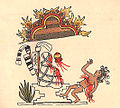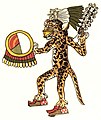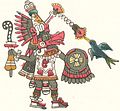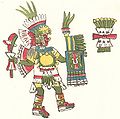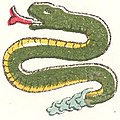Codex Magliabechiano

The Codex Magliabechiano is a pictorial Aztec codex created during the mid-16th century, in the early Spanish colonial period. It is representative of a set of codices known collectively as the Magliabechiano Group (others in the group include the Codex Tudela and the Codex Ixtlilxochitl). The Codex Magliabechiano is based on an earlier unknown codex, which is assumed to have been the prototype for the Magliabechiano Group. It is named after Antonio Magliabechi, a 17th-century Italian manuscript collector, and is held in the Biblioteca Nazionale Centrale, Florence, Italy.

It was created on European paper, with drawings and Spanish language text on both sides of each page. The Codex Magliabechiano is primarily a religious document. Various deities, indigenous religious rites, costumes, and cosmological beliefs are depicted. Its 92 pages are almost a glossary of cosmological and religious elements. The 52-year cycle is depicted, as well as the 20 day-names of the tonalpohualli, and the 18 monthly feasts.
Images
[edit]-
The first four day-symbols of the tonalpohualli: Flint, Rain, Flower, Crocodile. (Page 11, reverse) (the Rain day-symbol resembles symbol of Tlaloc)
-
Depicts the Aztec calendrical signs for the days 5 Wind, 6 House, 7 Lizard and 8 Snake. (Folio 11v)
-
Calendrical signs for the days 9 Death, 10 Deer, 11 Rabbit and 12 Water. (Folio 12r)
-
Calendrical signs for the days 4 Jaguar, 5 Eagle, 6 Vulture and 7 Quake. (Folio 13r)
-
page 141 (folio 70r)
-
page 141 (folio 70r)
-
A depiction of cannibalism in Aztec culture. (Folio 73r)
-
Possibly depicting Tititl festival
-
Victim of the ritual sacrificial combat named Sacrificio Gladiatorio in spanish and Tlahuahuanaliztli o tlauauaniliztli in nahuatl, as portrayed in the folio 30r
-
Could be Manta ornament
-
Could be Quetzalcoatl
-
Could be Techalotl
-
Could be Tzitzimitl
SVG renderings
-
Calli (house)
-
Tochtli (rabbit)
-
Xochitl (flower)
-
Mazatl (deer)
Icons
-
Acatl (reed)
-
Cipactli (crocodile)
-
Coatl (serpent)
-
Cozcacuauhtli (vulture)
-
Cuauhtli (eagle)
-
Cuetzpalin (lizard)
-
Itzcuintli (dog)
-
Malinalli (grass)
-
Miquiztli (death)
-
Ocelotl (ocelot)
-
Olin (movement)
-
Ozomatli (monkey)
-
Quiahuitl (rain)
-
Tecpatl (flint)
References
[edit]- Boone, Elizabeth Hill (1983). The Codex Magliabechiano and the Lost Prototype of the Magliabechiano Group (issued together with reprint of The Book of the Life of the Ancient Mexicans by Zelia Nuttall [1903], part 2 in two-volume set ed.). Berkeley: University of California Press. ISBN 0-520-04520-3. OCLC 8113016.
- Talakh, Viktor; Kupriienko, Sergii (2013) [2013]. Codex Magliabecchiano (russian). Kyiv: Видавець Купрієнко С.А. ISBN 978-617-7085-04-0. Retrieved 4 September 2013.
Further reading
[edit]- Carrasco, David. (2001). The Oxford Encyclopedia of Mesoamerican Cultures: The Civilizations of Mexico and Central America. Oxford. ISBN 0-19-510815-9.
- Facsimile: Codex Magliabechiano, Florence, Biblioteca Nazionale Centrale, Middle of the 16th century; Akademische Druck- u. Verlagsanstalt (ADEVA) Graz 1970. Colour facsimile edition of the manuscript in possession of the Biblioteca Nazionale Centrale di Firenze. 186 pp., size: 215 x 155 mm. Encased in box with leather spine. Introduction (in German), summaries (in English and Spanish): F. Anders, Vienna, 78 pp., 1 plate; CODICES SELECTI, Vol. XXIII
External links
[edit]Complete color facsimiles of the hand-painted manuscript in the National Central Library in Florence
- Codex Magliabechiano (Graz, 1970)
- Codex Magliabecchiano (Rome, 1904)







